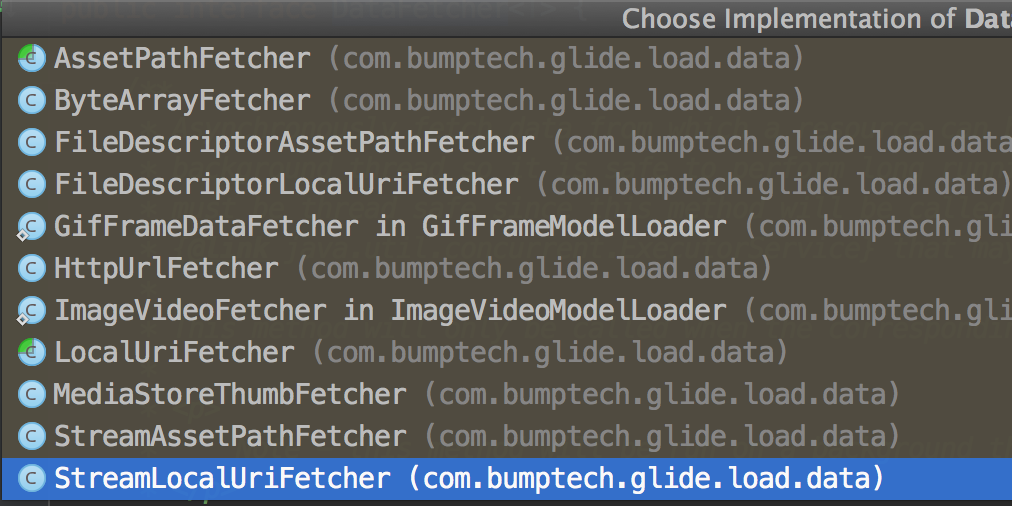使用最为基本的用法:
Glide.with(this).load(imageUr).into(imageView);
Glide.with(this)
分析
0、先来看看RequestManager中的成员变量
public class RequestManager implements LifecycleListener {
private final Context context;
/**生命周期管理**/
private final Lifecycle lifecycle;
private final RequestManagerTreeNode treeNode;
private final RequestTracker requestTracker;
private final Glide glide;
/**配置注入者**/
private final OptionsApplier optionsApplier;
/**默认的配置**/
private DefaultOptions options;
}
1、RequestManagerRetriever.get()获取到RequestManagerRetriever的单例;
2、retriever.get(activity)获取到RequestManager的实例,作用是:
这里会根据当前代码的所处线程和activity的类别(Activity,FragmentActivity,Frament和context(contextWrapper)),getApplicationManager到不同的RequestManager。
-如果是后台线程,会再次询问是否仍在后台线程中运行,如果是的话就创建一个RequestManager的对象
private RequestManager getApplicationManager(Context context) {
// Either an application context or we're on a background thread.
if (applicationManager == null) {
synchronized (this) {
if (applicationManager == null) {
// Normally pause/resume is taken care of by the fragment we add to the fragment or activity.
// However, in this case since the manager attached to the application will not receive lifecycle
// events, we must force the manager to start resumed using ApplicationLifecycle.
applicationManager = new RequestManager(context.getApplicationContext(),
new ApplicationLifecycle(), new EmptyRequestManagerTreeNode());
}
}
}
return applicationManager;
}
从注释中可以得知:处于后台运行中的或者使用Application创建的RequestManager,是不能监听到Application已经启动的回调的,于是就force the manager to start resumed using ApplicationLifecycle。
-如果在非后台线程:
-FragmentActivity:
public RequestManager get(FragmentActivity activity) {
if (Util.isOnBackgroundThread()) {
return get(activity.getApplicationContext());
} else {
assertNotDestroyed(activity);
/**每次都会新建一个FragmentManager的对象**/
FragmentManager fm = activity.getSupportFragmentManager();
return supportFragmentGet(activity, fm);
}
}
.load(imageUrl)
/**
* Returns a request builder to load the given {@link java.lang.String}.
* signature.
*
* @see #fromString()
* @see #load(Object)
*
* @param string A file path, or a uri or url handled by {@link com.bumptech.glide.load.model.UriLoader}.
*/
public DrawableTypeRequest load(String string) {
return (DrawableTypeRequest) fromString().load(string);
}
fromString()
private DrawableTypeRequest loadGeneric(Class modelClass) {
ModelLoader streamModelLoader = Glide.buildStreamModelLoader(modelClass, context);
ModelLoader fileDescriptorModelLoader =
Glide.buildFileDescriptorModelLoader(modelClass, context);
if (modelClass != null && streamModelLoader == null && fileDescriptorModelLoader == null) {
throw new IllegalArgumentException("Unknown type " + modelClass + ". You must provide a Model of a type for"
+ " which there is a registered ModelLoader, if you are using a custom model, you must first call"
+ " Glide#register with a ModelLoaderFactory for your custom model class");
}
/**利用配置注入者将配置注入**/
return optionsApplier.apply(
new DrawableTypeRequest(modelClass, streamModelLoader, fileDescriptorModelLoader, context,
glide, requestTracker, lifecycle, optionsApplier));
}
这样,就得到了一个DrawableTypeRequest(继承与GenericRequestBuilder),以下是继承关系图(as中按F4)

load()
这个倒是没有什么,就是说明接下来使用的DrawableTypeRequest中的ModelType是何种类型的。而这个ModelType解释是:
The type of model representing the resource.
into()
return into(glide.buildImageViewTarget(view, transcodeClass));
会先生成一个ImageViewTarget
public class ImageViewTargetFactory {
@SuppressWarnings("unchecked")
public Target buildTarget(ImageView view, Class clazz) {
if (GlideDrawable.class.isAssignableFrom(clazz)) {
return (Target) new GlideDrawableImageViewTarget(view);
} else if (Bitmap.class.equals(clazz)) {
return (Target) new BitmapImageViewTarget(view);
} else if (Drawable.class.isAssignableFrom(clazz)) {
return (Target) new DrawableImageViewTarget(view);
} else {
throw new IllegalArgumentException("Unhandled class: " + clazz
+ ", try .as*(Class).transcode(ResourceTranscoder)");
}
}
}
再来执行最终的生成request对象和request的过程
/**
* Set the target the resource will be loaded into.
*
* @see Glide#clear(com.bumptech.glide.request.target.Target)
*
* @param target The target to load the resource into.
* @return The given target.
*/
public > Y into(Y target) {
Util.assertMainThread();
if (target == null) {
throw new IllegalArgumentException("You must pass in a non null Target");
}
if (!isModelSet) {
throw new IllegalArgumentException("You must first set a model (try #load())");
}
/**其实就是获取view中的tag(Request对象)**/
Request previous = target.getRequest();
/**如果该view有已经有Request请求了,那么就先取消**/
if (previous != null) {
previous.clear();
requestTracker.removeRequest(previous);
previous.recycle();
}
Request request = buildRequest(target);
/**设置view的tag **/
target.setRequest(request);
/**添加请求过程中的生命周期**/
lifecycle.addListener(target);
requestTracker.runRequest(request);
return target;
}
然后就runRequest了
/**
* Starts tracking the given request.
*/
public void runRequest(Request request) {
requests.add(request);
if (!isPaused) {
request.begin();
} else {
pendingRequests.add(request);
}
}
接下来就是request开始执行:
先来看看Engine都有什么成员变量
public class Engine implements EngineJobListener,
MemoryCache.ResourceRemovedListener,
EngineResource.ResourceListener {
private static final String TAG = "Engine";
/**存储EngineJob的集合**/
private final Map jobs;
private final EngineKeyFactory keyFactory;
private final MemoryCache cache;
private final EngineJobFactory engineJobFactory;
private final Map>> activeResources;
private final ResourceRecycler resourceRecycler;
private final LazyDiskCacheProvider diskCacheProvider;
// Lazily instantiate to avoid exceptions if Glide is initialized on a background thread. See #295.
private ReferenceQueue> resourceReferenceQueue;
/**
* Allows a request to indicate it no longer is interested in a given load.
*/
public static class LoadStatus {
private final EngineJob engineJob;
private final ResourceCallback cb;
public LoadStatus(ResourceCallback cb, EngineJob engineJob) {
this.cb = cb;
this.engineJob = engineJob;
}
public void cancel() {
engineJob.removeCallback(cb);
}
}
EngineRunnable****(实际进行图片请求的****task)
@Override
public void run() {
......
Exception exception = null;
Resource resource = null;
try {
/** task运行的核心代码**/
resource = decode();
} catch (Exception e) {
if (Log.isLoggable(TAG, Log.VERBOSE)) {
Log.v(TAG, "Exception decoding", e);
}
exception = e;
}
......
}
然后会执行decode()方法
private Resource decode() throws Exception {
if (isDecodingFromCache()) {
return decodeFromCache();
} else {
return decodeFromSource();
}
}
看decodeResultFromCache()方法
public Resource decodeResultFromCache() throws Exception {
if (!diskCacheStrategy.cacheResult()) {
return null;
}
long startTime = LogTime.getLogTime();
Resource transformed = loadFromCache(resultKey);
if (Log.isLoggable(TAG, Log.VERBOSE)) {
logWithTimeAndKey("Decoded transformed from cache", startTime);
}
startTime = LogTime.getLogTime();
/**这里把从cache中拿到的结果进行转码,后面做详细的分析**/
Resource result = transcode(transformed);
if (Log.isLoggable(TAG, Log.VERBOSE)) {
logWithTimeAndKey("Transcoded transformed from cache", startTime);
}
return result;
}
private Resource decodeSource() throws Exception {
Resource decoded = null;
try {
long startTime = LogTime.getLogTime();
/**使用ExecutorService组织请求**/
final A data = fetcher.loadData(priority);
if (Log.isLoggable(TAG, Log.VERBOSE)) {
logWithTimeAndKey("Fetched data", startTime);
}
if (isCancelled) {
return null;
}
decoded = decodeFromSourceData(data);
} finally {
fetcher.cleanup();
}
return decoded;
}
其中fetcher是接口DataFetcher对象,DataFetcher的实现类包括:

以
HttpUrlFetcher为例分析:
@Override
public InputStream loadData(Priority priority) throws Exception {
return loadDataWithRedirects(glideUrl.toURL(), 0 /*redirects*/, null /*lastUrl*/, glideUrl.getHeaders());
}
-glideUrl.toURL():这里需要安全的装换到一个可以访问的URL,具体可见http://stackoverflow.com/questions/3286067/url-encoding-in-android
final int statusCode = urlConnection.getResponseCode();
if (statusCode / 100 == 2) {
return getStreamForSuccessfulRequest(urlConnection);
} else if (statusCode / 100 == 3) {
String redirectUrlString = urlConnection.getHeaderField("Location");
if (TextUtils.isEmpty(redirectUrlString)) {
throw new IOException("Received empty or null redirect url");
}
URL redirectUrl = new URL(url, redirectUrlString);
return loadDataWithRedirects(redirectUrl, redirects + 1, url, headers);
} else {
if (statusCode == -1) {
throw new IOException("Unable to retrieve response code from HttpUrlConnection.");
}
throw new IOException("Request failed " + statusCode + ": " + urlConnection.getResponseMessage());
}
-如果返回的code是3开头的重定向请求,那么需要获取重定向的地址,重新组织访问。